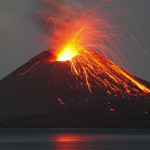Category: Geography
Created by: Silentchapel
Number of Blossarys: 95
It is difficult to distinguish an extinct volcano from a dormant (inactive) one. Volcanoes are often considered to be extinct if there are no written records of its activity. Nevertheless, volcanoes ...
Extinct volcanoes are those that scientists consider unlikely to erupt again, because the volcano no longer has a magma supply. Examples of extinct volcanoes are many volcanoes on the Hawaiian – ...
There is no consensus among volcanologists on how to define an "active" volcano. The lifespan of a volcano can vary from months to several million years, making such a distinction sometimes ...
A pyroclastic flow (also known scientifically as a pyroclastic density current) is a fast-moving current of hot gas and rock (collectively known as tephra), which reaches speeds moving away from a ...
Submarine volcanoes are underwater vents or fissures in the Earth's surface from which magma can erupt. They are estimated to account for 75% of annual magma output. The vast majority are located ...
A supervolcano is any volcano capable of producing a volcanic eruption with an ejecta volume greater than 1,000 km3 (240 cu mi). This is thousands of times larger than normal volcanic eruptions. ...
A lahar is a type of mudflow or debris flow composed of a slurry of pyroclastic material, rocky debris, and water. The material flows down from a volcano, typically along a river valley. Lahars are ...


 English (EN)
English (EN) 





